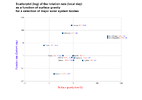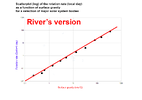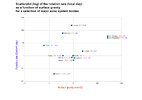DaveC426913
Valued Senior Member
river keeps posting this. Thought this would be a good place to corral all this thoughts into one.
I am not sure exactly what his assertion is, but various posts seem to indicate that he thinks the rotation rate of a celestial body, such as a planet or moon, gives rise to that body's gravity.
Literally: without rotation about its axis, a body would have no gravity.
Or somesuch. I don't want to speak for river; it is his idea, it should explained in his own words.
Here are some:
I invite river to post his idea,in full, here. Ideally, post 2, so that it can serve as the referent for the rest of the thead.
Meanwhile, to see if there is any correlation at all, here is a chart showing rotation rate versus surface gravity of various SS bodies. If there were a correlation, this graph should show a strong trend line.
I invite river to explain this correlation he sees:

If he'd like I can flip the axes to show surface gravity as a function of rotation rate, but really it's the same graph.
Gonna be fun to explain those two data points for the sun.
If surface gravity is directly proportional to rotation rate,
then how does the sun have two different rotation rates depending on latitude, yet the same surface gravity for both?
That pretty much means gravity is not directly proporional to rotation rate.
I am not sure exactly what his assertion is, but various posts seem to indicate that he thinks the rotation rate of a celestial body, such as a planet or moon, gives rise to that body's gravity.
Literally: without rotation about its axis, a body would have no gravity.
Or somesuch. I don't want to speak for river; it is his idea, it should explained in his own words.
Here are some:
There are many others, scattered throughout various threads.Spin , the faster the spin along with density of the medium , the stronger the gravity . Gravity has direction because of rotation .
I invite river to post his idea,in full, here. Ideally, post 2, so that it can serve as the referent for the rest of the thead.
Meanwhile, to see if there is any correlation at all, here is a chart showing rotation rate versus surface gravity of various SS bodies. If there were a correlation, this graph should show a strong trend line.
I invite river to explain this correlation he sees:

If he'd like I can flip the axes to show surface gravity as a function of rotation rate, but really it's the same graph.
Gonna be fun to explain those two data points for the sun.
If surface gravity is directly proportional to rotation rate,
then how does the sun have two different rotation rates depending on latitude, yet the same surface gravity for both?
That pretty much means gravity is not directly proporional to rotation rate.
Last edited:


